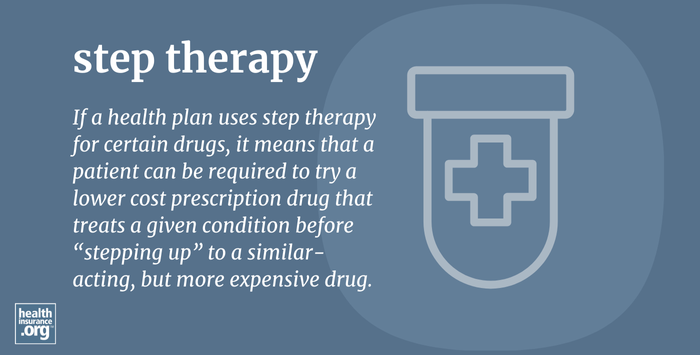
What is step therapy?
If a health plan uses step therapy for certain drugs, it means that a patient can be required to try a lower cost prescription drug that treats a given condition before “stepping up” to a similar-acting, but more expensive drug. The health plan won't cover the more expensive drug until the lower-cost medication has failed to treat the patient's condition. Other names for step therapy are “step protocol” and “fail first requirements.”
Step therapy is a very common cost-control strategy. Step therapy generally saves money for both the patient and the health plan.
What are the benefits of step therapy?
The primary benefit of step therapy is lower drug costs for both the patient and the health plan.
The clinical basis for step therapy is that some conditions can be treated with different but therapeutically equivalent medications and there is not a good way to predict if a particular medication will be more or less effective for any one individual. In those cases, it is more cost-effective to start with a "step 1" drug – a generic drug or lower-cost or preferred brand-name drug – before trying a more expensive or non-preferred drug. Step 1 drugs are on a lower tier of a formulary, so the consumer pays a lower copay.
For the health plan, the base price (or ingredient cost) is typically lower for a low-tier vs. high-tier drug. Drug tiering and preferred/non-preferred status can also depend on the rebates that the health plan's pharmacy benefits manager receives from the drug manufacturer.
How can step therapy be harmful to patients?
Step therapy can be detrimental for a patient if the lower-cost drug doesn't work for them, since they will have to ensure the ineffective treatment for a certain amount of time. Step therapy can also be disruptive when a consumer moves from one insurer to another. A consumer might have tried one or more step 1 therapies under one health plan only to move to another health plan that requires the consumer to start over – or has different classifications of step 1 and step 2 medications. In these cases, your doctor may need to work with your new insurance plan to get a prior authorization (also called a step therapy exception or coverage determination) to continue coverage for the drug therapy that has been working well for you.
How common is step therapy?
According to one analysis reported on PubMed, health plans used step therapy in about 40% of drug coverage policies.1 But about 90% of prescriptions filled in the U.S. are for generic drugs,2 which tend to be lower-costs alternatives and thus not subject to step therapy.
How does step therapy work?
If your new prescription requires step therapy, the pharmacy looks back at your drug history to see if you’ve tried the step 1 therapy within a given time period. If you have, the pharmacy fills the prescription as usual. If you haven’t previously tried a step 1 therapy, the pharmacist will work with your doctor to get a different prescription or work with your doctor and insurance company to request coverage for the originally prescribed drug.
How do I know which drugs require step therapy?
You can look at your health plan’s formulary to find out if a drug requires step therapy. The health plan may have mailed you a paper copy of the formulary, or you can find it on the plan’s website. And, your doctor can likely see step therapy requirements in an electronic prescribing (e-prescribing) tool.
Footnotes
- "Variation In Use And Content Of Prescription Drug Step Therapy Protocols, Within And Across Health Plans" National Library of Medicine. Nov. 2021 ⤶
- "Office of Generic Drugs 2021 Annual Report" U.S. Food and Drug Administration. Accessed Nov. 18, 2024 ⤶


